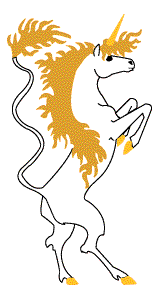| Revision as of 13:56, 5 March 2004 view sourceWiglaf (talk | contribs)20,911 editsNo edit summary← Previous edit | Revision as of 13:58, 5 March 2004 view source Wiglaf (talk | contribs)20,911 editsNo edit summaryNext edit → | ||
| Line 4: | Line 4: | ||
| <div style="float:right;margin-left:1em;">]</div> | <div style="float:right;margin-left:1em;">]</div> | ||
| It has been proposed that the unicorn is based on an extinct animal called '''giant unicorn''', or ], a huge ] ] with a single horn in the forehead. |
It has been proposed that the unicorn is based on an extinct animal called '''giant unicorn''', or ], a huge ] ] with a single horn in the forehead. According to an early 19th century Scaninavian encyclopedia, and to ], the animal may have survived long enough to be remembered in ] legends (a huge black bull with a single horn in the forehead). Moreover, there is a testimony by ] (who is usually regarded as a reliable historical soruce) which closely resembles an elasmotherium. This connection is also supported by the legend's derivation from the Persian '''karkadann''' which was larger than an elephant. The relation between the two animals is uncertain, but a '''real''' giant unicorn was once seen and hunted by man. | ||
| According to an interpretation of seals with an animal which resembles a bull (and which may in fact be a way of depicting bulls in profile), it has been claimed that the unicorn was a common symbol during the ], appearing on many ]. It may have symbolised a powerful group. | According to an interpretation of seals with an animal which resembles a bull (and which may in fact be a way of depicting bulls in profile), it has been claimed that the unicorn was a common symbol during the ], appearing on many ]. It may have symbolised a powerful group. | ||
Revision as of 13:58, 5 March 2004
The unicorn is a legendary creature shaped like a horse but with a single - usually spiral - horn growing out of its forehead. Some accounts describe it as having the body of a deer and the head of a lion.

It has been proposed that the unicorn is based on an extinct animal called giant unicorn, or elasmotherium, a huge Eurasian rhinoceros with a single horn in the forehead. According to an early 19th century Scaninavian encyclopedia, and to Willy Ley, the animal may have survived long enough to be remembered in Evenki legends (a huge black bull with a single horn in the forehead). Moreover, there is a testimony by Ibn Fadlan (who is usually regarded as a reliable historical soruce) which closely resembles an elasmotherium. This connection is also supported by the legend's derivation from the Persian karkadann which was larger than an elephant. The relation between the two animals is uncertain, but a real giant unicorn was once seen and hunted by man.
According to an interpretation of seals with an animal which resembles a bull (and which may in fact be a way of depicting bulls in profile), it has been claimed that the unicorn was a common symbol during the Indus Valley Civilisation, appearing on many seals. It may have symbolised a powerful group.
Ancient Greek accounts of unicorns locate their habitat in India (see Indian Rhinoceros). The unicorn did not appear in Greek mythology, but as an actual - albeit exotic - beast.
In medieval times, entrepreneurs would occasionally manufacture a unicorn by surgery on a goat kid: they would remove one horn bud and relocate the other to the centre of the forehead. (This technique continued to as recently as the 20th century, for circus displays.) Narwhal tusks, however, provided the main source of "unicorn" horns.
In popular belief, unicorn horns could neutralize poisons. Therefore, people who feared poisoning sometimes drank from goblets made of "unicorn horn". Alleged aphrodisiac qualities and other purported medicinal virtues also drove up the cost of "unicorn" products such as milk, hide and offal. Unicorns were also said to be able to determine whether or not a woman was a virgin; in some tales, they could only be mounted by virgins.
The unicorn also served as a common symbol of purity and of Jesus Christ. The traditional method of hunting unicorns involved entrapment by a virgin. This is believed to stem from the method of trapping Rhinos, a creature that may have inspired some medieval accounts of unicorns, in Africa. A female monkey would be taken to where the Rhinos were and would dance for them. The Rhinos would become mesmerised by the antics of the monkey and would thus be an easier target for the hunters.
The unicorn also functions as a national symbol of Scotland and appears on many British symbols, notably as a supporter of coats of arms.
In fantasy fiction, a unicorn often has magical qualities or powers.
The constellation Monoceros represents a unicorn.